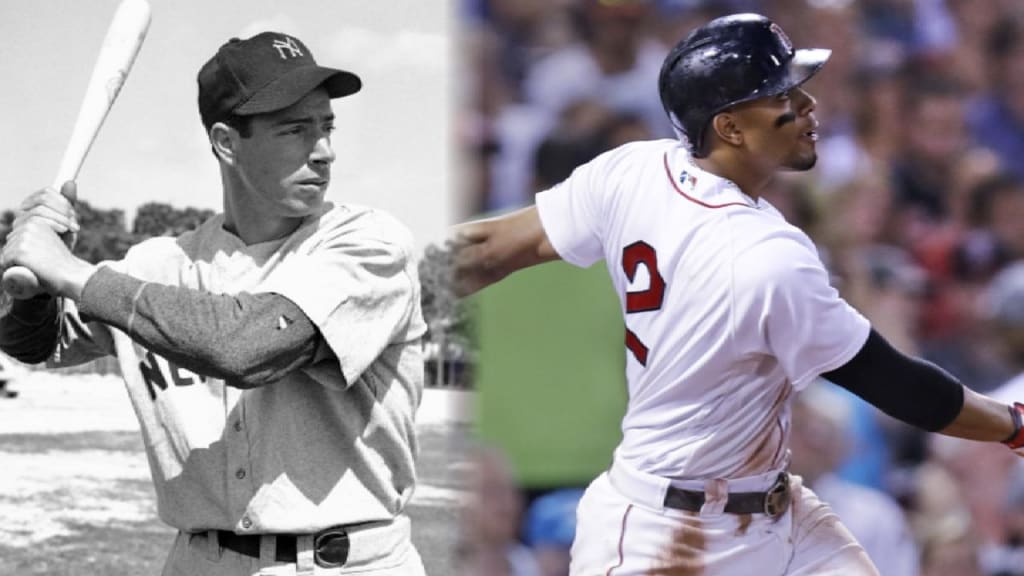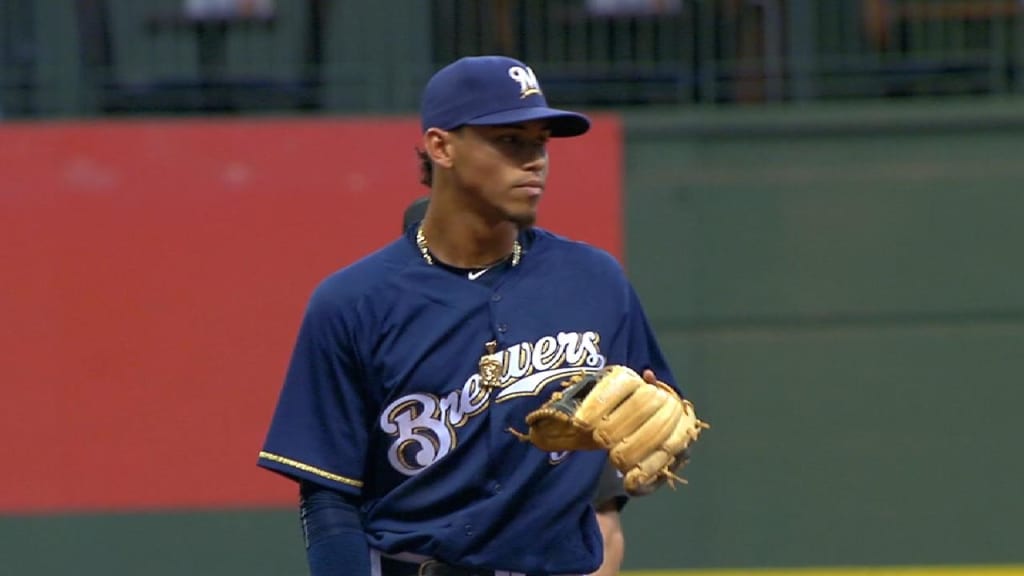Can Statcast help top 56-game hit streak?
This browser does not support the video element.
In 1941, the Yankees' Joe DiMaggio put together a 56-game hitting streak, helping cement not only the Hall of Famer's legend, but also his place in any debate about unbreakable records.
Since then, few players have mounted a serious challenge to DiMaggio. Only Pete Rose, with 44 straight games for the 1978 Reds, has crossed the 40-game threshold during that time. And over the past 30 seasons, just one player has come within 20 games of the record -- Jimmy Rollins (38) with the 2005-06 Phillies.
In the homer- and strikeout-filled environment of the past three seasons, the longest hitting streak belongs to the Braves' Freddie Freeman (30 games in 2016), while just 10 others reached the 20-game mark. In other words, DiMaggio seems as far out of reach as ever.
But what if modern technology provided a way to bring this hallowed record within reach? What if we can use Statcast™, and a little imagination, to "hack" our way to 56?
That's where hit probability comes into play. The metric estimates the likelihood that a batted ball will become a hit, based on its combination of exit velocity and launch angle. Sometimes a screaming line drive with a high hit probability is caught for an out, and sometimes a lazy pop fly with a low hit probability drops for a single. That's baseball.
Using this hit probability data, MLB.com re-evaluated the results of the past three seasons -- since Statcast™ was introduced in 2015 -- in an attempt to construct a streak that would overthrow Joltin' Joe. Would a little dose of improved luck here and there have allowed someone to break the unbreakable record, or would the numbers only solidify the mystique of 56?
Here are the results, broken down into two main methods:
Method No. 1: Applying the 'Statcast™ Boost'
The first strategy involved trying to extend actual hitting streaks by focusing on the hitless games that interrupted them. On a day in which the player did not get a hit but put at least one ball in play with a hit probability of greater than 50 percent, the streak continued. If the player failed to get a hit or put a ball in play with a hit probability of at least 50 percent, the streak ended.
This "Statcast™ Boost" certainly made an impact. Under these rules, there were 56 players who posted at least one streak of 20 or more games from 2015-17. Yet it wasn't enough.
In reality, the longest hit streak of 2017 was 21 games by the Phillies' Odúbel Herrera. By the "Statcast™ Boost" method, the longest streak was 33 games by the Indians' Francisco Lindor, from July 16-Aug. 20. The Boost filled in five hitless games for Lindor, such as an Aug. 4 tilt against the Yankees. In the second inning of that one, Lindor ripped an 86.1-mph line drive with an 11-degree launch angle and a 72 percent hit probability toward left field, only to have shortstop Didi Gregorius rob him with a leaping grab.
With that misfortune corrected, Lindor's longest streak of the year increased by 20 games, but that still left him well short of DiMaggio.
Over the past three seasons, the longest streak remains Freeman's in 2016, but the "Statcast™ Boost" would pull him even with Rose at 44 games. Freeman actually hit safely in 30 straight games from Aug. 24-Sept. 28 that year, but this method extends his run back to Aug. 8.
Freeman went 0-for-3 on both Aug. 9 at Milwaukee and Aug. 23 at Arizona. In both cases he posted a hit probability above 50 percent on a groundout up the middle that may have been thwarted by infield shifts, including a 108.4-mph shot (57 percent hit probability) handled by the Brewers' Orlando Arcia.
This browser does not support the video element.
Erase those setbacks, however, and Freeman is still about two hot weeks shy of DiMaggio.
It was clear that the "Statcast™ Boost" needed to be supercharged, so the next step was to figure out just how low to drop the minimum hit probability in order to create a streak of at least 56 games. As it turned out, the answer was "quite low."
Taking that original 50 percent figure and dropping it all the way to 29 percent finally did the job. This time, it was Lindor shattering the record by going 61 consecutive games from June 20-Aug. 27, 2017 -- with that 29 percent hit probability minimum applied to 14 games in which Lindor went hitless.
That means counting an Aug. 21 contest against the Red Sox that saw Lindor post hit probabilities of 16 percent, 17 percent and 29 percent on his three batted balls, the best of those on what was essentially a routine ground ball to shortstop.
Method No. 2: Starting from scratch
Yes, sometimes batters make outs when hit probability suggests they deserve a better fate. But luck works both ways.
Therefore, instead of simply using hit probabilities to replace real-life results in a player's hitless games, what would happen if every batted ball were judged solely by hit probability?
Not surprisingly, such a strategy makes catching The Yankee Clipper all the more difficult, as in some cases batters lose unlikely hits. Take Herrera's 21-game hitting streak, the longest of 2017. On Aug. 6, the Phillies' center fielder extended that run to 10 games at Coors Field despite his best batted ball being a slow grounder with a 10 percent hit probability that snuck up the middle for a hustle double.
This browser does not support the video element.
Using this method for every batter over the past three seasons, the minimum hit probability must drop all the way down to 23 percent to create a new record. In other words, any game in which a hitter managed at least one batted ball with that hit probability or better -- regardless of outcome -- extended the streak.
Under these conditions, Red Sox shortstop Xander Bogaerts strung together a 58-game streak, beginning with the final three games of the 2015 season and continuing through the following June 4. During that span, which included 49 games with at least one real-life hit, Bogaerts would have lost 11 knocks with hit probabilities below 23 percent but gained 38 hits on outs with hit probabilities that reached that level.
Bogaerts would have benefited on May 5, 2016, during an 0-for-4 night against the White Sox that was his only hitless performance during a 33-game stretch. Bogaerts' five fruitless plate appearances included both a line drive right at second baseman Brett Lawrie (58 percent) and a liner to center field (81 percent) that went for a sacrifice fly when Austin Jackson converted a 4-star catch.
This browser does not support the video element.
That streak would be tagged with an asterisk, however, since it was split over multiple seasons. Catching DiMaggio within a single season would require lowering the minimum hit probability threshold a bit more, to 20 percent. That would allow Lindor to put together a 64-game streak, from June 17-Aug. 27, 2017, during which his net gain would have been 48 hits.
Conclusion
There's a reason DiMaggio's streak is considered by many to be untouchable.
Even using advanced Statcast™ metrics in an attempt to manufacture a 56-game streak out of three seasons worth of results, it's no easy task. This isn't simply a matter of adjusting a snared line drive here and a warning-track out there. Catching DiMaggio requires some extreme data manipulation, turning numerous fairly routine outs into hits.
That doesn't prohibit anyone from breaking the record, as the game continues to evolve in the years to come. But at this point in time, DiMaggio's epic achievement remains, at best, a distant target.

